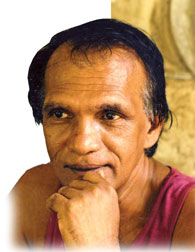|
Review:
Complex grammar and syntax of painting
By Indeewara Thilakarathne
|

Rubert Soysa |
Every artist dips his brush in his own soul, and paints his own
nature into his pictures.- Henry Ward Beecher (1813 - 1887), Proverbs
from Plymouth Pulpit, 1887
Influenced by the classical abstract paintings, contemporary Sri
Lankan professional painter Rubert Soysa who, over the years, has
evolved a unique language of paintings with his signature brush strokes.
His complex grammar and the syntax of painting, is buttressed by the
ingenious use of primary colours such as green, red and brown. His forte
seems to be in the abstract genre of paintings. He is at best in
conveying philosophical ideas of life, subjecting his paintings to
multiple interpretations and readers. At closer look, they are human
figures under myriads of shades and colours.
Tapestry
However, the rudimentary tapestry of colour which dominates the
backdrop of painting is blurred to depict the human figures which invest
meanings in the paintings.
This characteristic is amply manifested in the collection of
paintings which Rubert Soysa exhibited at O.S.B Folkets hus art gallery
in Sweden. The exhibition of abstract painting is made up of 30
creations on diverse themes although the paintings are untitled.
However, the dominant theme of the exhibition is human figure and they
depict the complex matrix of human relationships in diverse contexts. A
review of the exhibition was carried out in Swedish newspaper
Lanstidngen. The medium of the painting was oil on canvas.
One of the insightful paintings of the collection was one that
depicts the merge of woman faces. The faces sketched out against the
dark green backdrop, perhaps, embodying the agony of a woman. At closer
look, the faces seem to be of a woman in melancholy mood.
It can be Janus- faced of a woman. To capture the intense emotions,
the artist has skilfully used red, yellow and brown smudges in a
predominantly green backdrop which in another way suggest the
wounded-feelings of the woman. Obviously the woman's relationship with
the society and other seems to be difficult. The chaotic mindscape of
the woman is aptly depicted through deliberate thick brush strokes and
smudges.
Human figures
There are a couple of paintings in the collection with human figures
in meditation posture. There are four human figures in meditation in a
painting. They meditate against the white background and the human
figures are smudged to conceal any identification. It is extremely
difficult even to figure out whether they are male or female figures.
For the creation the artist has used white and blue as principal
colures. One of the significant creations is the cross-legged human
figure in meditation posture.
The figure is painted with yellow and black against the predominantly
green backdrop. The complex relationship that the human figure may have
been maintaining with others is depicted by way of patches and smudges.
Rubert's language of painting is complex in that he tries to give his
figures in his creations a universal identity superseding individual
identities.
It is obvious that human figure in his abstract paintings can
represent men and women in any culture and country. Therefore, they are
not culture-specific or country specific. It is due to this universality
that enables cosmopolitan audiences to appreciate Rubert's paintings.
His abstracts come out of a life-long dedication to paintings,
mastering the craft and manipulating the surrealistic effect of shades,
smudges and thin brush strokes. It is in this highly evolved language he
registers complex matrix of emotions on canvas. Some colours such as red
have been sparingly used to highlight the sheer intensity of emotions of
men and women who constitute his subject matter for creations.
A significant aspect of his abstracts is the way in which he
approaches his subject. For instance, there are instances where he has
turned his strong impressions into abstracts.
Complex web
The centrality of the abstracts are the complex web of human
relationships at both micro and macro levels. Human face though depicted
as vague as a set of blurred lines of varying length and width, making
only the contours, has been portrayed throughout his creations as an
individual's emotional outlet to the society at large.
The turbulent undercurrents in the emotional landscapes of
individuals have been skilfully captured in the form of ingenious use of
shades of colours. For instance, in a painting of a woman's face, the
shade of red has gradually been toned down to yellow indicating the
contrasting changes of her emotions.
The collection is full of such intricate human figures which are
subjecting to multiple readings. Ultimately the value of creation lies
in its inconclusive nature yielding many meanings and readings. In that
sense, Rubert Soysa's creations are outstanding and of lasting value.
|

